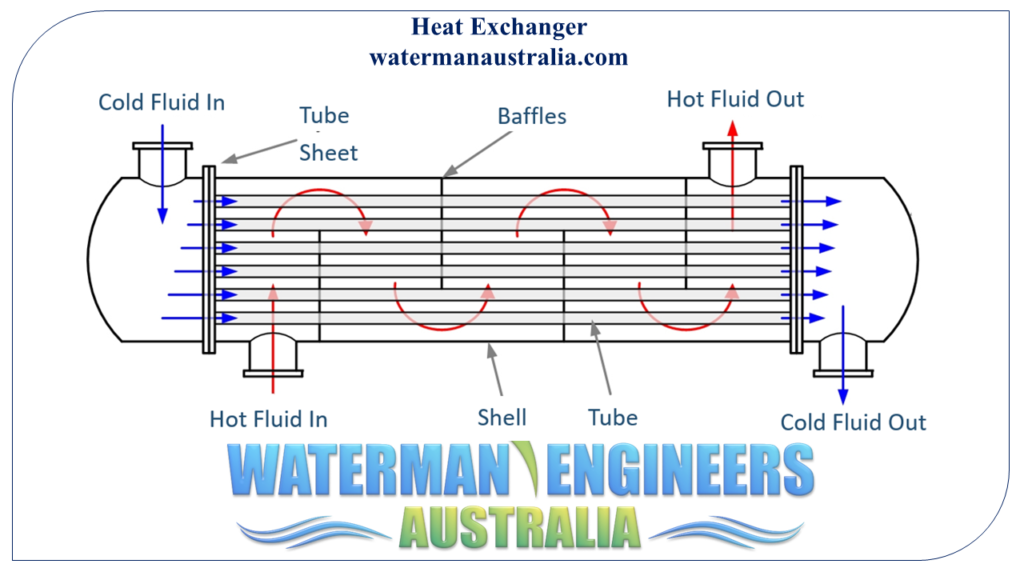
A heat exchanger is a device that allows for the transmission of heat between two different media without any physical contact between them. Heat exchangers work on the idea that thermal energy can be transferred from a hot fluid to a cold fluid. Heat exchangers provide for precise temperature regulation, improving energy efficiency and system functionality by transferring heat between two fluids.
Power plants, chemical plants, HVAC (heating, ventilation, and air conditioning) systems, supermarkets, and many more all employ heat exchangers. They can be found in commonplace home products like air conditioners and water heaters.
In this article, we'll learn about heat exchangers, what they are, how they work, and the different kinds there are. The article also details the common uses and factors to consider when choosing a heat exchanger.
Following introducing The fundamental heat transfer ideas and parameters, an summary of style and design methodologies is talked over. Subsequently, facts of layout principle of varied different types of exchangers are offered. The first edition established itself since the common one-volume text on the topic. The second edition preserves an established in-depth technique but demonstrates some new technological developments connected to design for manufacturing compact heat exchangers, like novel 3-D printing ways to heat exchanger layout. Visitors of the second version of Fundamentals of Heat Exchanger Design and style will likely discover:
A mix of air-cooling followed by downstream h2o (identified as trim) cooling is common. For instance, at a plant web-site the place the air structure temperature is forty°C, cooling down to 55°C will probably be by air cooler and even more cooling by water cooler.
When your gas furnace gets to be too hot, the Restrict switch will initiate to shut from the gas as a security precaution. It detects the temperature inside of the furnace and when it senses that it’s much too hot, the Restrict swap will transform from the gas.
And not using a subpoena, voluntary compliance over the portion of your respective Online Support Service provider, or more data from a 3rd party, details saved or retrieved for this purpose by yourself are unable to usually be used to recognize you. Advertising and marketing Advertising
Jessica considers herself a home advancement and design and style enthusiast. She grew up surrounded by frequent household advancement jobs and owes a lot of what she understands to supporting her father renovate her childhood household.
Initially, heat exchangers made use of aluminum plates. Difficulties transpired with corrosion during the moist ecosystem, created by condensation, and poor seem qualities. Plastics solved the corrosion plus some audio problems, however the conductivity did not equivalent that in the aluminum and the fee was higher. Present superior-technology heat exchangers use composite supplies Conference all of the factors.
Plate-fin evaporators Possess a compact structure, using a number of metallic plates with fins to transfer heat. They’re effective and lightweight, but can be susceptible to frost buildup. You’ll often come across these in smaller fridges.
Suction gas subcoolers great the refrigerant by exchanging heat Along with the suction fuel getting back from the evaporator. They might help enhance efficiency, but may insert complexity for the process.
They're going to then deliver a sample design to Narayanan’s lab for tension testing and thermal characterization to check out if it’s able to withstanding high temperatures involving 800 °C and 850 °C.
The 3D-printing method is perfect for large-temperature, high-force heat exchangers because the exchanger alone is composed of one block—there aren't any welded or brazed joints which can fall short, Narayanan said.
Air cooled heat exchangers are A different sort of exchanger layout Designing of heat exchanger manufacturer located in automotive programs to cool the motor.
Fluids with substantial temperature difference across just one go shall be located within the shell aspect to lessen the axial compressive rigidity and avoid the expansion joint.
While traditional heat-pump air conditioners use fluorocarbon refrigerants that lead to world-wide warming, lessening the refrigerant charge has a tendency to decrease heat exchanger efficiency. To lower refrigerant charge as well as make improvements to heat exchanger functionality, Mitsubishi Electrical centered on cutting down The inner quantity from the heat exchanger and increasing the area region of air in connection with the refrigerant, partly by compactly arranging numerous smaller-diameter flat tubes.
An axial circulation unit uses a substantial wheel. The air warms 1 aspect of the wheel, which transfers heat on the chilly air stream as it bit by bit turns. A heat pipe device makes use of refrigerant to transfer the heat. Other models are offered for specialized programs. Smaller structures, including properties, frequently use counter-movement or cross-circulation exchangers.